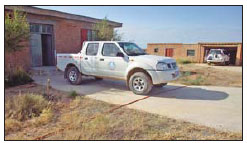Life and Leisure
Not easy to spot a houbara in the wild
By Chen Liang (China Daily)
Updated: 2010-11-01 07:31
 |
Large Medium Small |
|
The houbara research station is located right in the middle of the study area. [Photo/China Daily] |
It took me three days and more than eight hours of rough jeep travel every day to see a dozen houbara bustards in the wild.
Most were just blurry images in the telescope's eyepiece - meaning they were barely 1 or 2 km from the vehicle.
"Autumn is the best season to see the bird, besides their breeding season between mid-April and July, as they get ready for their migration then," says Xu Wenxuan, a doctorate student with the Xinjiang Institute of Ecology and Geography (XIEG), who is studying the bird with XIEG scientist Yang Weikang.
"Mori is the best place to see them because our study area here hosts the bird's densest population in the country."
Surrounded by low grass and bushes, the Mori research station is a compound housing a building and a courtyard. There Xu, another of Yang's doctoral students, Xia Canjun, and Blank David, an Israeli zoologist who is with the institute under a one-year exchange program, are making the regular autumn survey between Sept 1 and 15.
Every day they drive in two jeeps into the rangeland and count the houbaras and their predators.
They usually leave the station at 7:30 in the morning and return for lunch at noon before leaving again at 5, to return at 8:30 pm. They cover different parts of the study area sprawled over 3,000 sq km.
"That means covering 100 km every day," Xia says.
For a visitor like me, their work is truly fascinating. We stop several times during our drive, trying to catch sight of the bustards - first through binoculars and then through a telescope.
Spotting these shy birds, with only their crowns and long necks poking through the dense bushes, is very exciting.
Even if you don't spot the houbara, there is always that chance encounter with a fox strolling across the lane, or a buzzard hovering ahead, to keep your senses keyed.
For the researchers, however, such surveys can be tedious. "Sometimes, you could be driving the whole day without catching sight of a single bird," Xu says.
Still, 2010 has been "a big year" for houbara sightings. The Mori team has recorded 285 encounters with the birds. In 2008 and 2009, the numbers barely reached 200.
"The average numbers of encounters are 100-120 in spring and 150-180 in autumn," Xu says. "We haven't figured out the reason for 2010's increase but probably the long winter has pushed more houbaras to breed in the south."
While counting the houbaras with Xu and David, I saw a heap of houbara feathers near a section of the fence on the rangeland and a feather on the fence itself.
"The young birds fly quite low when startled into flight by a predator or car," Xu explains. "They run into the fence, get killed and become their predator's free meals."
Ten years ago, Yang says, the steppes were free of fencing. "Now it is completely fenced," he says. "The largest one is 25 km long and 25 km wide."
Fencing is aimed at restoring the overgrazed grasslands. However, every fenced project at the Mori site has two or three entrances. "We can drive in and out freely," Xu says. "So can local Kazakh herders and their cattle."
Hundreds of camels graze freely at the rangeland all year round. "They often destroy the houbaras' nests on the ground," David says.
An expert on the goitred gazelle, David says fencing is also driving the local gazelles away. "You could easily see many goitred gazelles galloping here several years ago," he says. "How many can you see now?"
I spotted four over three days, whose images appeared as blurred as those of the bustards I saw earlier.
